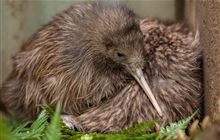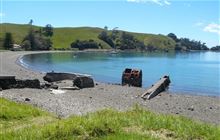Pest-free Motutapu Island helping save rare kiwi
Archived content: This media release was accurate on the date of publication.
Introduction
Four-week old kūpapa is the 96th Coromandel brown kiwi to be released on pest-free Motutapu Island as part of a programme to secure the survival of this rare brown kiwi.Date: 11 April 2019
It’s estimated there are only 1700 Coromandel brown kiwi on the Coromandel Peninsula.
There are four genetically distinct forms of North Island brown kiwi: Northland brown kiwi, Coromandel brown kiwi, Western brown kiwi and Eastern brown kiwi.
“We’re releasing Coromandel brown kiwi on pest-free Motutapu to build a generically robust population on the island,” says Kiwis for kiwi Executive Director Michelle Impey.
“We’re doing this by working with community-led kiwi conservation projects and DOC to collect kiwi eggs from different parts of the Coromandel.”
Volunteers take the eggs to Auckland Zoo and the National Kiwi Hatchery Aotearoa at Rainbow Springs Nature Park in Rotorua to be hatched. The chicks are taken to Motutapu where they’re welcomed by mana whenua, Ngāi Tai ki Tāmaki.
Kūpapa was named by Ngāi Tai ki Tāmaki representative Reuben Kirkwood in honour of an ancestor who bought Ngāi Tai ki Tāmaki back to Motutapu, when it was safe to do so, after Rangitoto erupted.
Like all kiwi released on Motutapu, Kūpapa was placed in a burrow in native forest planted by Motutapu Restoration Trust volunteers. They’ve planted 450,000 native trees creating a 100-hectare native forest on Motutapu.
Kūpapa was hatched at Auckland Zoo and joins 95 other Coromandel brown kiwi released on Motutapu since 2012.
“Taking eggs from different areas on the Coromandel enables us to mix the genes and breed healthier and more robust kiwi,” says Michelle Impey.
“We’re aiming to establish a self-sustaining population of about 150 breeding pairs of kiwi on Motutapu. Kiwi chicks bred on the island will be taken to the Coromandel and released into predator-controlled areas.”
“This will increase the number and genetic diversity of kiwi on the Coromandel helping to ensure we don’t lose this rare brown kiwi.”
Motutapu and Rangitoto (the islands are joined by a short bridge) were declared free of rats, stoats, possums and other introduced predators that eat the eggs and chicks of native birds, in 2011.
All kiwi struggle to survive in areas without predator control. Only about 5% of wild-born kiwi chicks survive to adulthood in areas where predators are not controlled. In predator-controlled areas, 50% to 60% of chicks survive. Kiwi populations are increasing in predator-controlled areas.
Approximately 20% of the kiwi population live in areas where predators are controlled.
About Kiwis for kiwi
Kiwis for kiwi is an independent charity launched in October 2012. Kiwis for kiwi works in partnership with DOC to protect kiwi and the areas they live throughout New Zealand.
Our national bird, the kiwi, is under constant siege in the wild from predators and the national kiwi population is in decline. It’s estimated there were a million kiwi in the wild 100 years ago. Today the kiwi population is down to around 70,000. Without support kiwi numbers will continue to fall with the risk that they will disappear in the wild.
Conservation work funded by Kiwis for kiwi, such as predator control, is very effective. Sixty per cent of kiwi chicks survive in areas where predators - in particular stoats - are controlled. In areas where there is no kiwi support, fewer than 5% of kiwi survive to adulthood.
Contact
For media enquiries contact:
Email: media@doc.govt.nz
Michelle Impey, Executive Director
Kiwis for kiwi
Mobile: +64 29 478 4610
Email: michelle@Kiwisforkiwi.org


